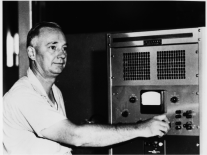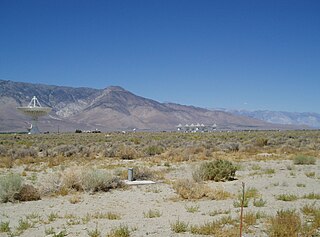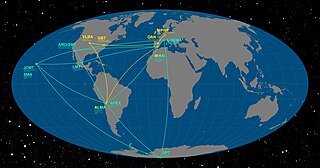
A radio telescope is a specialized antenna and radio receiver used to receive radio waves from astronomical radio sources in the sky in radio astronomy. Radio telescopes are the main observing instrument used in radio astronomy, which studies the radio frequency portion of the electromagnetic spectrum emitted by astronomical objects, just as optical telescopes are the main observing instrument used in traditional optical astronomy which studies the light wave portion of the spectrum coming from astronomical objects. Radio telescopes are typically large parabolic ("dish") antennas similar to those employed in tracking and communicating with satellites and space probes. They may be used singly or linked together electronically in an array. Unlike optical telescopes, radio telescopes can be used in the daytime as well as at night. Since astronomical radio sources such as planets, stars, nebulas and galaxies are very far away, the radio waves coming from them are extremely weak, so radio telescopes require very large antennas to collect enough radio energy to study them, and extremely sensitive receiving equipment. Radio observatories are preferentially located far from major centers of population to avoid electromagnetic interference (EMI) from radio, television, radar, motor vehicles, and other manmade electronic devices.

Radio astronomy is a subfield of astronomy that studies celestial objects at radio frequencies. The first detection of radio waves from an astronomical object was in 1932, when Karl Jansky at Bell Telephone Laboratories observed radiation coming from the Milky Way. Subsequent observations have identified a number of different sources of radio emission. These include stars and galaxies, as well as entirely new classes of objects, such as radio galaxies, quasars, pulsars, and masers. The discovery of the cosmic microwave background radiation, regarded as evidence for the Big Bang theory, was made through radio astronomy.

Karl Guthe Jansky was an American physicist and radio engineer who in August 1931 first discovered radio waves emanating from the Milky Way. He is considered one of the founding figures of radio astronomy.

The Karl G. Jansky Very Large Array (VLA) is a centimeter-wavelength radio astronomy observatory located in central New Mexico on the Plains of San Agustin, between the towns of Magdalena and Datil, ~40 miles (64 km) west of Socorro. The VLA comprises twenty-seven 25-meter radio telescopes deployed in a Y-shaped array and all the equipment, instrumentation, and computing power to function as an interferometer. Each of the massive telescopes is mounted on double parallel railroad tracks, so the radius and density of the array can be transformed to adjust the balance between its angular resolution and its surface brightness sensitivity. Astronomers using the VLA have made key observations of black holes and protoplanetary disks around young stars, discovered magnetic filaments and traced complex gas motions at the Milky Way's center, probed the Universe's cosmological parameters, and provided new knowledge about the physical mechanisms that produce radio emission.

The Robert C. Byrd Green Bank Telescope (GBT) in Green Bank, West Virginia, US is the world's largest fully steerable radio telescope. The Green Bank site was part of the National Radio Astronomy Observatory (NRAO) until September 30, 2016. Since October 1, 2016, the telescope has been operated by the newly separated Green Bank Observatory. The telescope honors the name of the late Senator Robert C. Byrd who represented West Virginia and who pushed the funding of the telescope through Congress.

Grote Reber was an American pioneer of radio astronomy, which combined his interests in amateur radio and amateur astronomy. He was instrumental in investigating and extending Karl Jansky's pioneering work, and conducted the first sky survey in the radio frequencies.

The Atacama Large Millimeter/submillimeter Array (ALMA) is an astronomical interferometer of 66 radio telescopes in the Atacama Desert of northern Chile, which observe electromagnetic radiation at millimeter and submillimeter wavelengths. The array has been constructed on the 5,000 m (16,000 ft) elevation Chajnantor plateau - near the Llano de Chajnantor Observatory and the Atacama Pathfinder Experiment. This location was chosen for its high elevation and low humidity, factors which are crucial to reduce noise and decrease signal attenuation due to Earth's atmosphere. ALMA is expected to provide insight on star birth during the early Stelliferous era and detailed imaging of local star and planet formation.

The National Radio Quiet Zone (NRQZ) is a large area of land in the United States designated as a radio quiet zone, in which radio transmissions are heavily restricted by law to facilitate scientific research and military intelligence. Roughly half of the zone is located in the Blue Ridge Mountains of west-central Virginia while the other half is the Allegheny Mountains of east-central West Virginia; a small part of the zone is in the southernmost tip of the Maryland panhandle.
James Richard Fisher is a scientist at the National Radio Astronomy Observatory at Charlottesville, VA. He received his Ph.D. in Astronomy in 1972 from the University of Maryland, College Park and his B.S. in Physics in 1965 from the Pennsylvania State University, University Park.

Owens Valley Radio Observatory (OVRO) is a radio astronomy observatory located near Big Pine, California (US) in Owens Valley. It lies east of the Sierra Nevada approximately 350 kilometers (220 mi) north of Los Angeles and 20 kilometers (12 mi) southeast of Bishop. It was established in 1958, and is owned and operated by the California Institute of Technology (Caltech). The Owens Valley Solar Array portion of the observatory has been operated by New Jersey Institute of Technology since the transfer in 1997.

Associated Universities, Inc. (AUI) is a research management corporation that builds and operates facilities for the research community. AUI is a not-for-profit 501(c)(3) corporation, headquartered in Washington, DC. The President is Dr. Adam Cohen. AUI's major current operating unit is the National Radio Astronomy Observatory (NRAO), which it operates under a Cooperative Agreement with the National Science Foundation.

The Algonquin Radio Observatory (ARO) is a radio observatory located in Algonquin Provincial Park in Ontario, Canada. It opened in 1959 in order to host a number of the National Research Council of Canada's (NRC) ongoing experiments in a more radio-quiet location than Ottawa.

The ARO 12m Radio Telescope is a 12-meter dish located on Kitt Peak, approximately 60 mi (100 km) from Tucson in Arizona at an elevation of 6215.8 ft.
Astronomical Image Processing System++ is a software package whose development was started in the early nineties, written almost entirely in C++, and which initial goal was to replace the by then already aging AIPS software. It has now been reborn as CASA and is the basis of the image processing systems for several next-generation radio telescopes including ALMA, eVLA, and ASKAP.

The Reber Radio Telescope is a historic radio telescope, located at the Green Bank Observatory near Green Bank, West Virginia. Built in 1937 in Illinois by astronomer Grote Reber, it is the first purpose-built parabolic radio telescope. It was designated a National Historic Landmark in 1989.

The Green Bank Interferometer (GBI) is a former radio astronomy telescope located at Green Bank, West Virginia (USA) and operated by the National Radio Astronomy Observatory (NRAO). It included three on-site radio telescopes of 85-foot (26m) diameter, designated 85-1, 85-3, and 85-2 and a portable telescope.

The Event Horizon Telescope (EHT) is a project to create a large telescope array consisting of a global network of radio telescopes and combining data from several very-long-baseline interferometry (VLBI) stations around the Earth. The aim is to observe the immediate environment of the supermassive black hole Sagittarius A* at the center of the Milky Way, as well as the even larger black hole in the supergiant elliptical galaxy Messier 87, with angular resolution comparable to the black hole's event horizon.

Iranian National Observatory (INO) aims at the construction of observing facilities for astronomical research and education purpose. The primary goal is the design and construction of a 4m-class optical telescope and other smaller observing facilities to respond to a growing demand. INO is executed at the Institute for Research in Fundamental Sciences, one of the leading research institutes in fundamental sciences.


















